Public Sector Auditing: Standards, Competencies, and Audit Types
VerifiedAdded on 2023/07/11
|14
|1089
|433
Presentation
AI Summary
This presentation provides a comprehensive overview of public sector auditing, starting with an introduction to auditing principles, objectives, advantages, and limitations. It covers the different types of audits, including internal, operational, external, compliance, IRS tax, financial, information system, payroll, and pay audits. The presentation details the four types of auditor opinions: unqualified, qualified, disclaimer of opinion, and adverse opinion. It further discusses the Standards on Auditing (SA) under the Clarity Project, focusing on risk assessment, responses to assessed risks, and specialized areas. The presentation also touches upon the INTOSAI competency framework for SAI audit professionals, highlighting cross-cutting competencies relevant to compliance, financial, and performance audits. The document is intended to provide a foundational understanding of public sector auditing practices and standards.
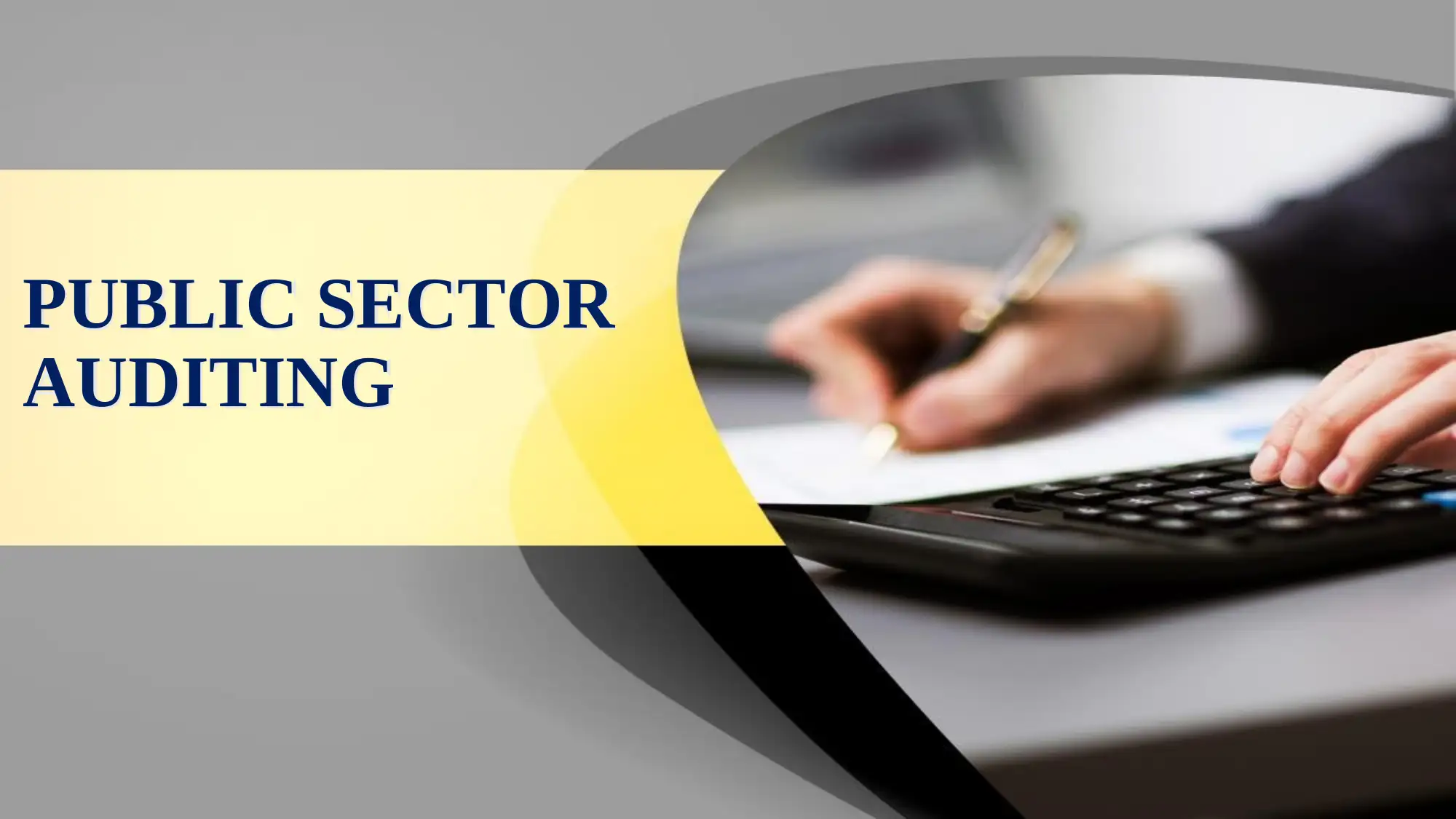
PUBLIC SECTOR
AUDITING
AUDITING
Paraphrase This Document
Need a fresh take? Get an instant paraphrase of this document with our AI Paraphraser
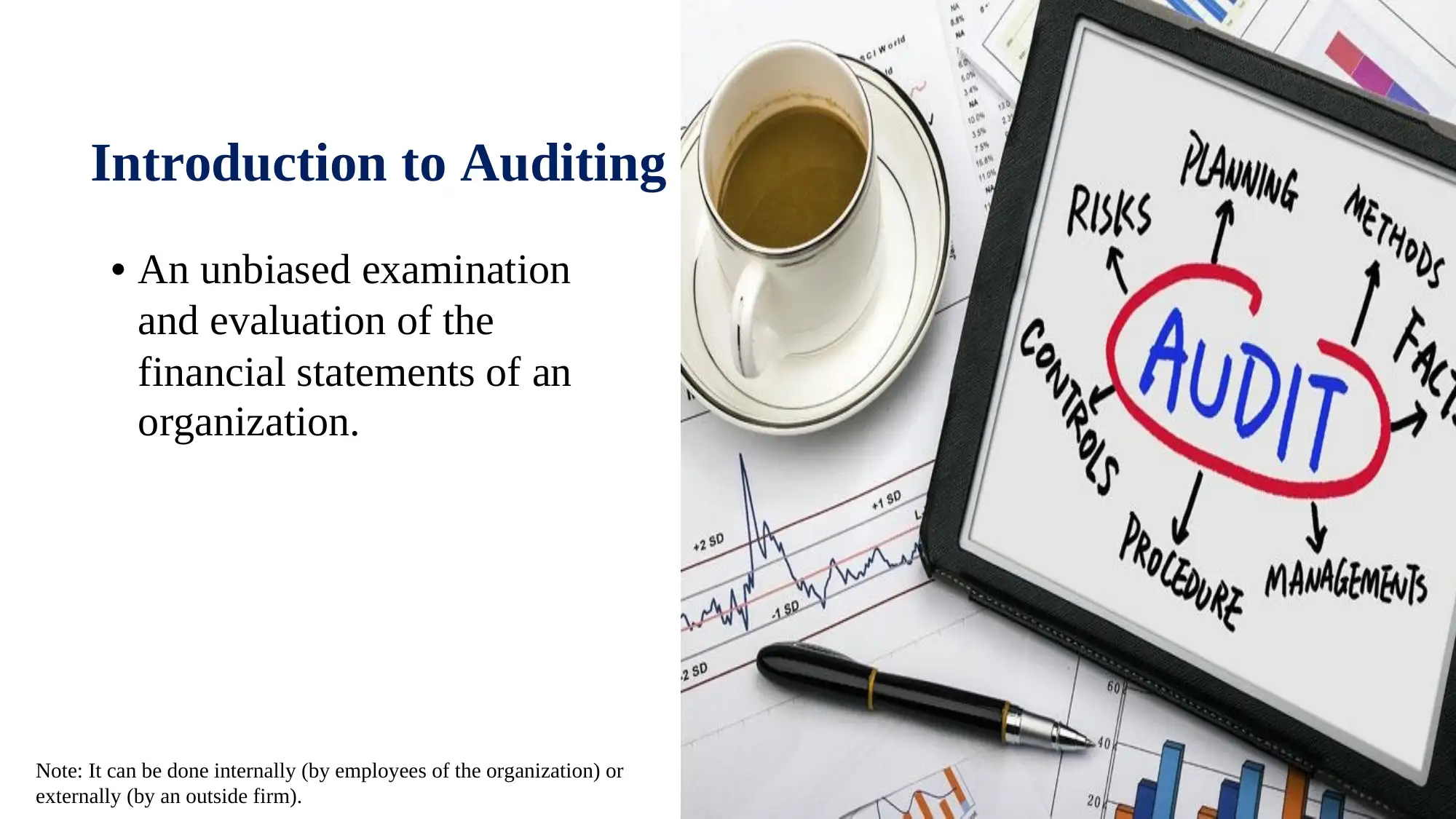
Introduction to Auditing
• An unbiased examination
and evaluation of the
financial statements of an
organization.
Note: It can be done internally (by employees of the organization) or
externally (by an outside firm).
• An unbiased examination
and evaluation of the
financial statements of an
organization.
Note: It can be done internally (by employees of the organization) or
externally (by an outside firm).
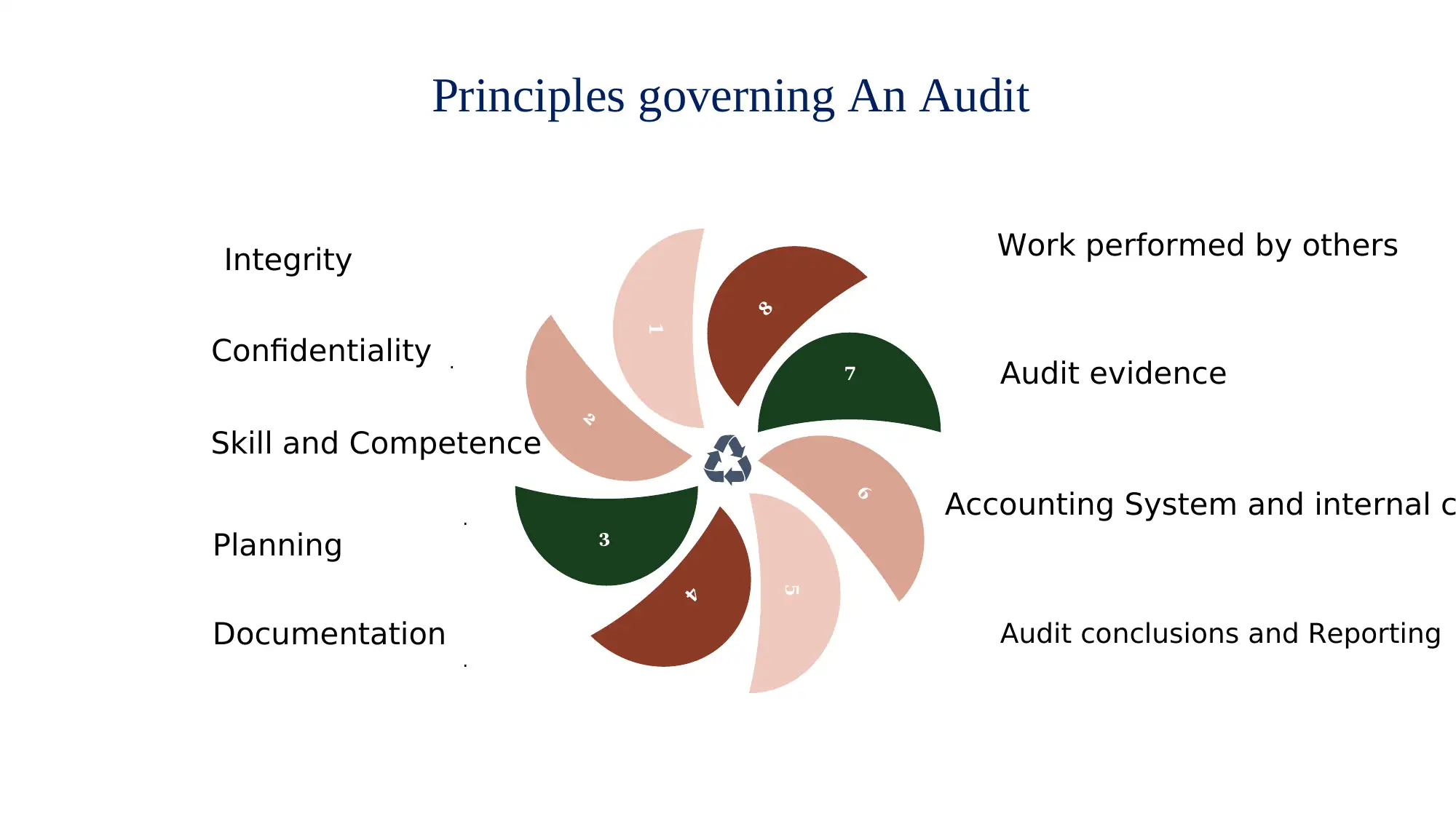
7
5
1
.
.
.
Principles governing An Audit
Integrity
Confidentiality
Skill and Competence
Planning
Documentation
Work performed by others
Audit evidence
Accounting System and internal c
Audit conclusions and Reporting
5
1
.
.
.
Principles governing An Audit
Integrity
Confidentiality
Skill and Competence
Planning
Documentation
Work performed by others
Audit evidence
Accounting System and internal c
Audit conclusions and Reporting
⊘ This is a preview!⊘
Do you want full access?
Subscribe today to unlock all pages.

Trusted by 1+ million students worldwide
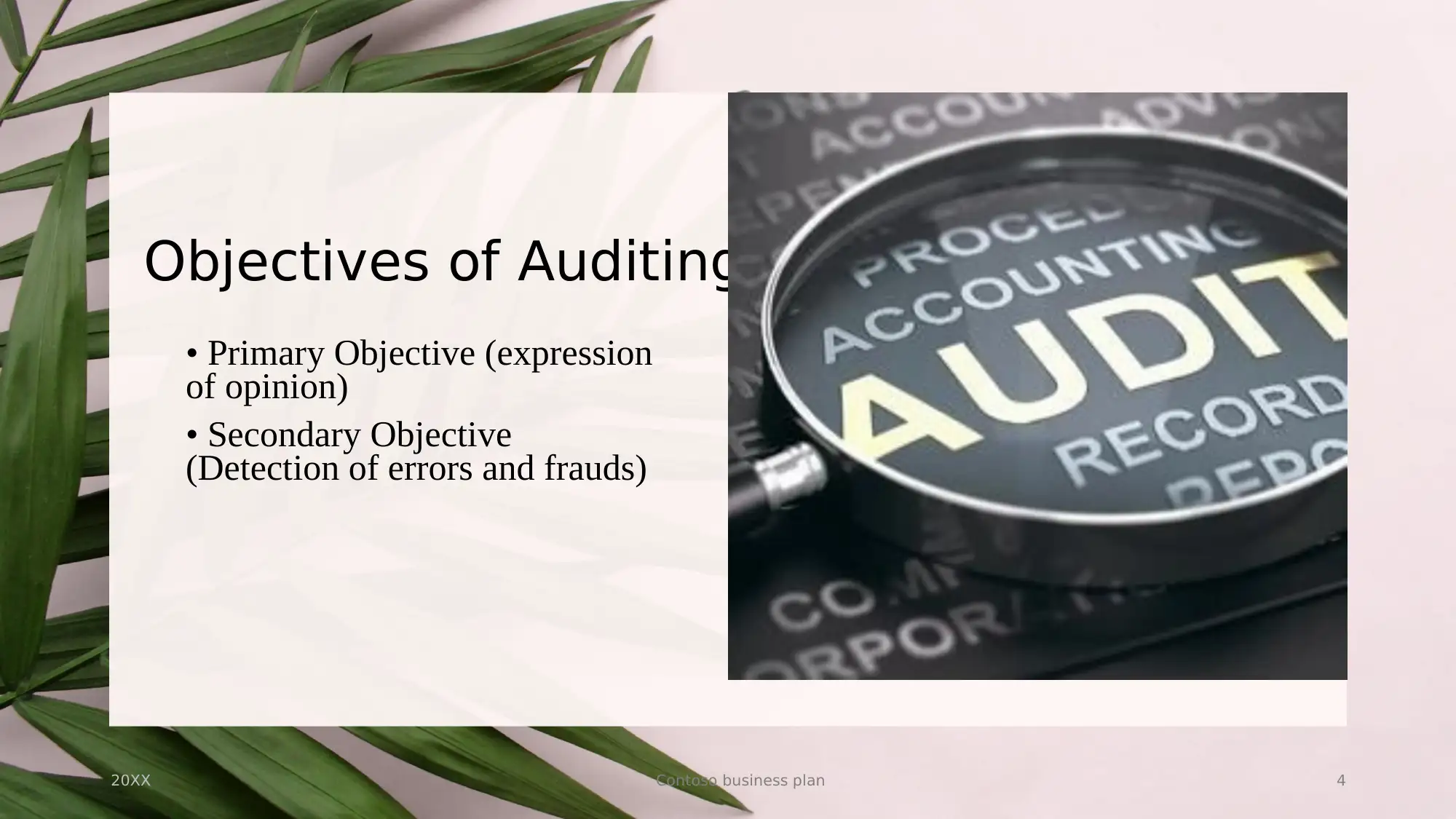
Objectives of Auditing
• Primary Objective (expression
of opinion)
• Secondary Objective
(Detection of errors and frauds)
20XX Contoso business plan 4
• Primary Objective (expression
of opinion)
• Secondary Objective
(Detection of errors and frauds)
20XX Contoso business plan 4
Paraphrase This Document
Need a fresh take? Get an instant paraphrase of this document with our AI Paraphraser
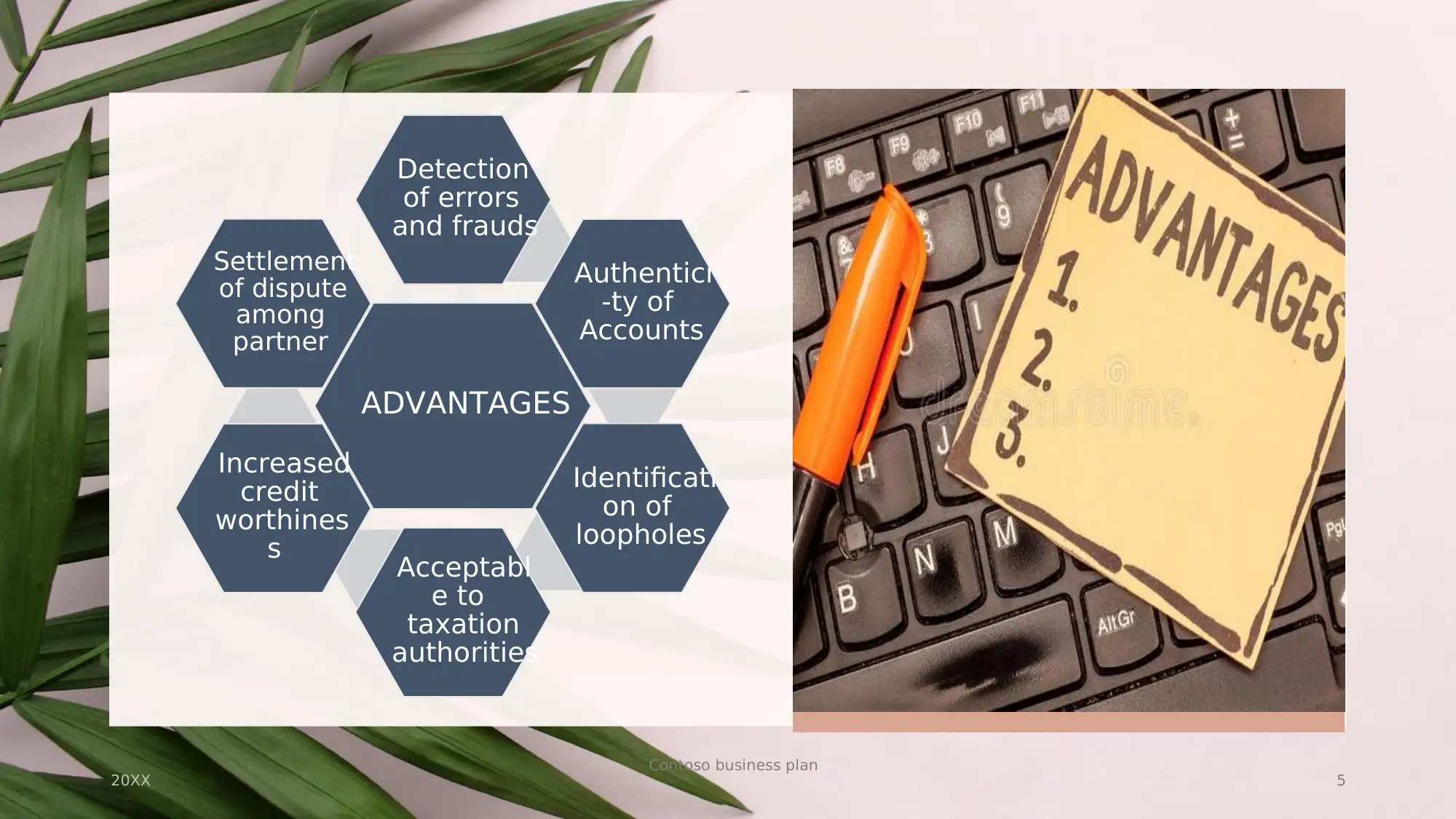
20XX
Contoso business plan
5
ADVANTAGES
Detection
of errors
and frauds
Authentici
-ty of
Accounts
Identificati
on of
loopholes
Acceptabl
e to
taxation
authorities
Increased
credit
worthines
s
Settlement
of dispute
among
partner
Contoso business plan
5
ADVANTAGES
Detection
of errors
and frauds
Authentici
-ty of
Accounts
Identificati
on of
loopholes
Acceptabl
e to
taxation
authorities
Increased
credit
worthines
s
Settlement
of dispute
among
partner

20XX
Contoso business plan
6
LIMITATIONS
Dependen
ce on
others
Time
consuming
Frauds not
detected
Costly
Depends
on
judgement
Contoso business plan
6
LIMITATIONS
Dependen
ce on
others
Time
consuming
Frauds not
detected
Costly
Depends
on
judgement
⊘ This is a preview!⊘
Do you want full access?
Subscribe today to unlock all pages.

Trusted by 1+ million students worldwide

20XX
Qualities of
an Auditor
Integrity
Objectivity
Independenc
e
Confidenti
ality
Communica
tion skills
Intelligent
Qualities of
an Auditor
Integrity
Objectivity
Independenc
e
Confidenti
ality
Communica
tion skills
Intelligent
Paraphrase This Document
Need a fresh take? Get an instant paraphrase of this document with our AI Paraphraser
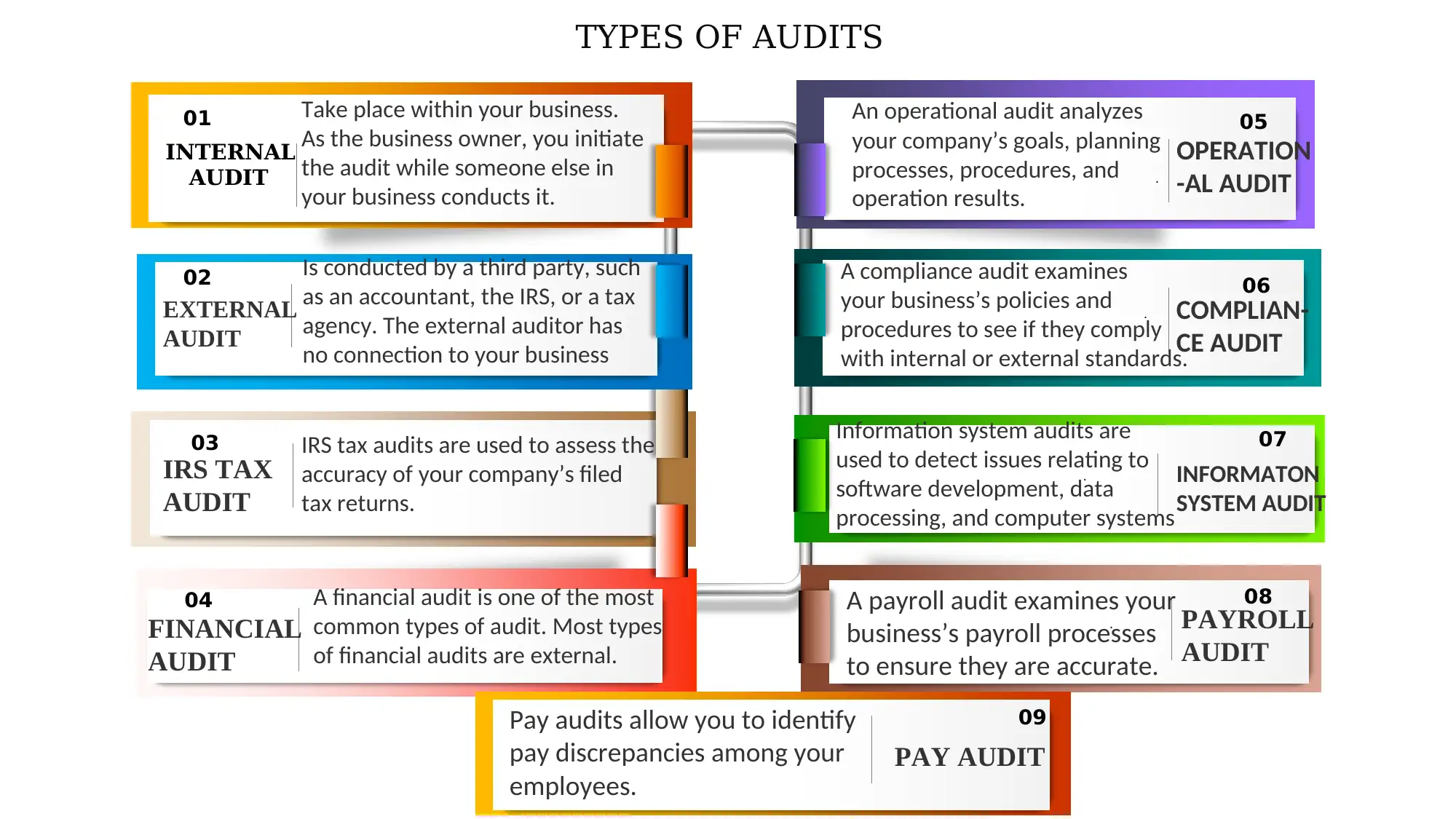
01
INTERNAL
AUDIT
03
02
04
05
07
06
08
.
.
.
.
TYPES OF AUDITS
09
PAY AUDIT
Take place within your business.
As the business owner, you initiate
the audit while someone else in
your business conducts it.
EXTERNAL
AUDIT
Is conducted by a third party, such
as an accountant, the IRS, or a tax
agency. The external auditor has
no connection to your business
IRS TAX
AUDIT
IRS tax audits are used to assess the
accuracy of your company’s filed
tax returns.
FINANCIAL
AUDIT
A financial audit is one of the most
common types of audit. Most types
of financial audits are external.
OPERATION
-AL AUDIT
An operational audit analyzes
your company’s goals, planning
processes, procedures, and
operation results.
COMPLIAN-
CE AUDIT
A compliance audit examines
your business’s policies and
procedures to see if they comply
with internal or external standards.
INFORMATON
SYSTEM AUDIT
Information system audits are
used to detect issues relating to
software development, data
processing, and computer systems
PAYROLL
AUDIT
A payroll audit examines your
business’s payroll processes
to ensure they are accurate.
Pay audits allow you to identify
pay discrepancies among your
employees.
INTERNAL
AUDIT
03
02
04
05
07
06
08
.
.
.
.
TYPES OF AUDITS
09
PAY AUDIT
Take place within your business.
As the business owner, you initiate
the audit while someone else in
your business conducts it.
EXTERNAL
AUDIT
Is conducted by a third party, such
as an accountant, the IRS, or a tax
agency. The external auditor has
no connection to your business
IRS TAX
AUDIT
IRS tax audits are used to assess the
accuracy of your company’s filed
tax returns.
FINANCIAL
AUDIT
A financial audit is one of the most
common types of audit. Most types
of financial audits are external.
OPERATION
-AL AUDIT
An operational audit analyzes
your company’s goals, planning
processes, procedures, and
operation results.
COMPLIAN-
CE AUDIT
A compliance audit examines
your business’s policies and
procedures to see if they comply
with internal or external standards.
INFORMATON
SYSTEM AUDIT
Information system audits are
used to detect issues relating to
software development, data
processing, and computer systems
PAYROLL
AUDIT
A payroll audit examines your
business’s payroll processes
to ensure they are accurate.
Pay audits allow you to identify
pay discrepancies among your
employees.
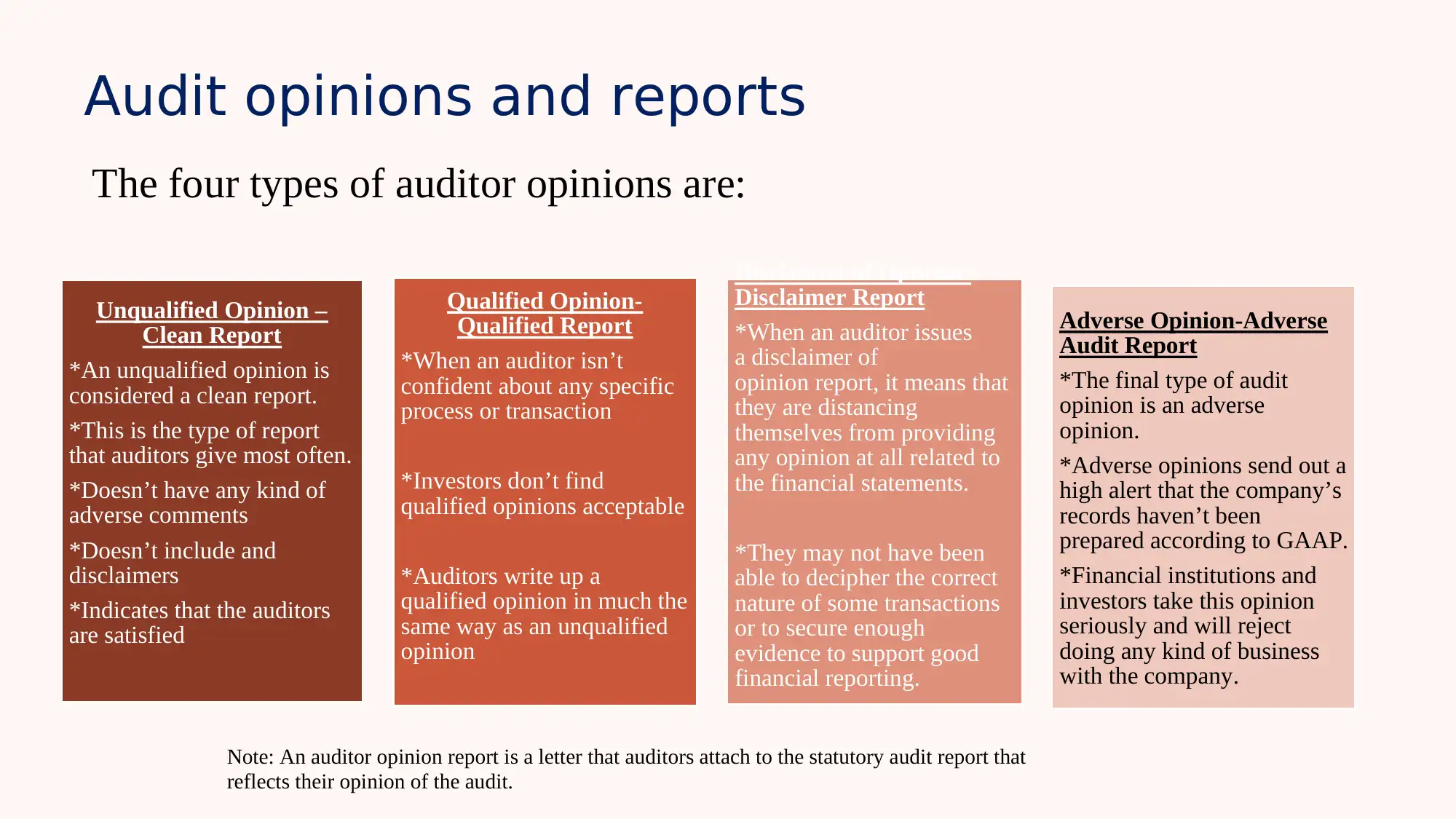
Audit opinions and reports
The four types of auditor opinions are:
Unqualified Opinion –
Clean Report
*An unqualified opinion is
considered a clean report.
*This is the type of report
that auditors give most often.
*Doesn’t have any kind of
adverse comments
*Doesn’t include and
disclaimers
*Indicates that the auditors
are satisfied
Qualified Opinion-
Qualified Report
*When an auditor isn’t
confident about any specific
process or transaction
*Investors don’t find
qualified opinions acceptable
*Auditors write up a
qualified opinion in much the
same way as an unqualified
opinion
Disclaimer of Opinion-
Disclaimer Report
*When an auditor issues
a disclaimer of
opinion report, it means that
they are distancing
themselves from providing
any opinion at all related to
the financial statements.
*They may not have been
able to decipher the correct
nature of some transactions
or to secure enough
evidence to support good
financial reporting.
Adverse Opinion-Adverse
Audit Report
*The final type of audit
opinion is an adverse
opinion.
*Adverse opinions send out a
high alert that the company’s
records haven’t been
prepared according to GAAP.
*Financial institutions and
investors take this opinion
seriously and will reject
doing any kind of business
with the company.
Note: An auditor opinion report is a letter that auditors attach to the statutory audit report that
reflects their opinion of the audit.
The four types of auditor opinions are:
Unqualified Opinion –
Clean Report
*An unqualified opinion is
considered a clean report.
*This is the type of report
that auditors give most often.
*Doesn’t have any kind of
adverse comments
*Doesn’t include and
disclaimers
*Indicates that the auditors
are satisfied
Qualified Opinion-
Qualified Report
*When an auditor isn’t
confident about any specific
process or transaction
*Investors don’t find
qualified opinions acceptable
*Auditors write up a
qualified opinion in much the
same way as an unqualified
opinion
Disclaimer of Opinion-
Disclaimer Report
*When an auditor issues
a disclaimer of
opinion report, it means that
they are distancing
themselves from providing
any opinion at all related to
the financial statements.
*They may not have been
able to decipher the correct
nature of some transactions
or to secure enough
evidence to support good
financial reporting.
Adverse Opinion-Adverse
Audit Report
*The final type of audit
opinion is an adverse
opinion.
*Adverse opinions send out a
high alert that the company’s
records haven’t been
prepared according to GAAP.
*Financial institutions and
investors take this opinion
seriously and will reject
doing any kind of business
with the company.
Note: An auditor opinion report is a letter that auditors attach to the statutory audit report that
reflects their opinion of the audit.
⊘ This is a preview!⊘
Do you want full access?
Subscribe today to unlock all pages.

Trusted by 1+ million students worldwide
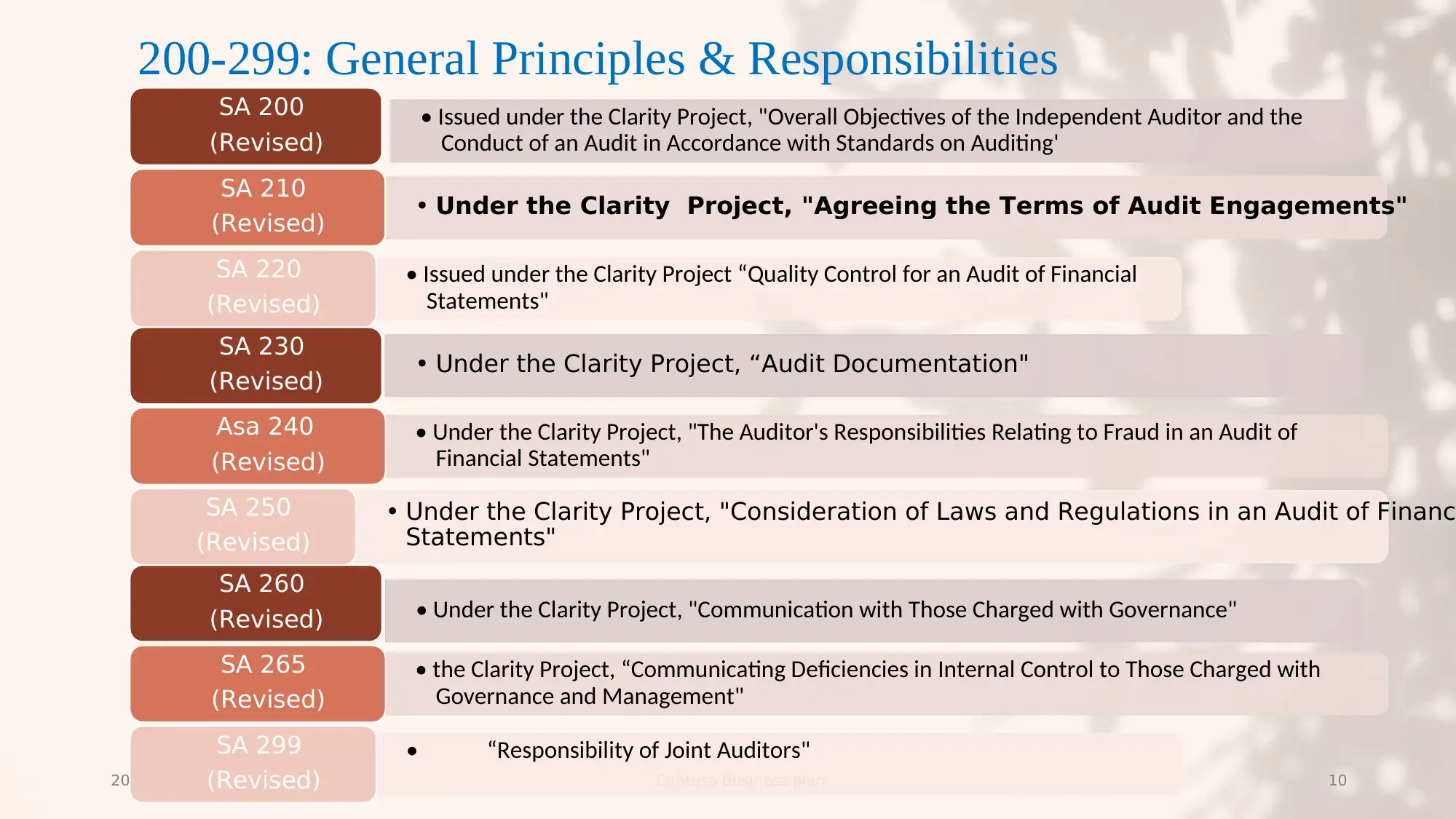
20XX Contoso business plan 10
• Issued under the Clarity Project, "Overall Objectives of the Independent Auditor and the
Conduct of an Audit in Accordance with Standards on Auditing'
SA 200
(Revised)
• Under the Clarity Project, "Agreeing the Terms of Audit Engagements"
SA 210
(Revised)
• Issued under the Clarity Project “Quality Control for an Audit of Financial
Statements"
SA 220
(Revised)
• Under the Clarity Project, “Audit Documentation"
SA 230
(Revised)
• Under the Clarity Project, "The Auditor's Responsibilities Relating to Fraud in an Audit of
Financial Statements"
Asa 240
(Revised)
• Under the Clarity Project, "Consideration of Laws and Regulations in an Audit of Financ
Statements"
SA 250
(Revised)
• Under the Clarity Project, "Communication with Those Charged with Governance"
SA 260
(Revised)
• the Clarity Project, “Communicating Deficiencies in Internal Control to Those Charged with
Governance and Management"
SA 265
(Revised)
• “Responsibility of Joint Auditors"SA 299
(Revised)
200-299: General Principles & Responsibilities
• Issued under the Clarity Project, "Overall Objectives of the Independent Auditor and the
Conduct of an Audit in Accordance with Standards on Auditing'
SA 200
(Revised)
• Under the Clarity Project, "Agreeing the Terms of Audit Engagements"
SA 210
(Revised)
• Issued under the Clarity Project “Quality Control for an Audit of Financial
Statements"
SA 220
(Revised)
• Under the Clarity Project, “Audit Documentation"
SA 230
(Revised)
• Under the Clarity Project, "The Auditor's Responsibilities Relating to Fraud in an Audit of
Financial Statements"
Asa 240
(Revised)
• Under the Clarity Project, "Consideration of Laws and Regulations in an Audit of Financ
Statements"
SA 250
(Revised)
• Under the Clarity Project, "Communication with Those Charged with Governance"
SA 260
(Revised)
• the Clarity Project, “Communicating Deficiencies in Internal Control to Those Charged with
Governance and Management"
SA 265
(Revised)
• “Responsibility of Joint Auditors"SA 299
(Revised)
200-299: General Principles & Responsibilities
Paraphrase This Document
Need a fresh take? Get an instant paraphrase of this document with our AI Paraphraser
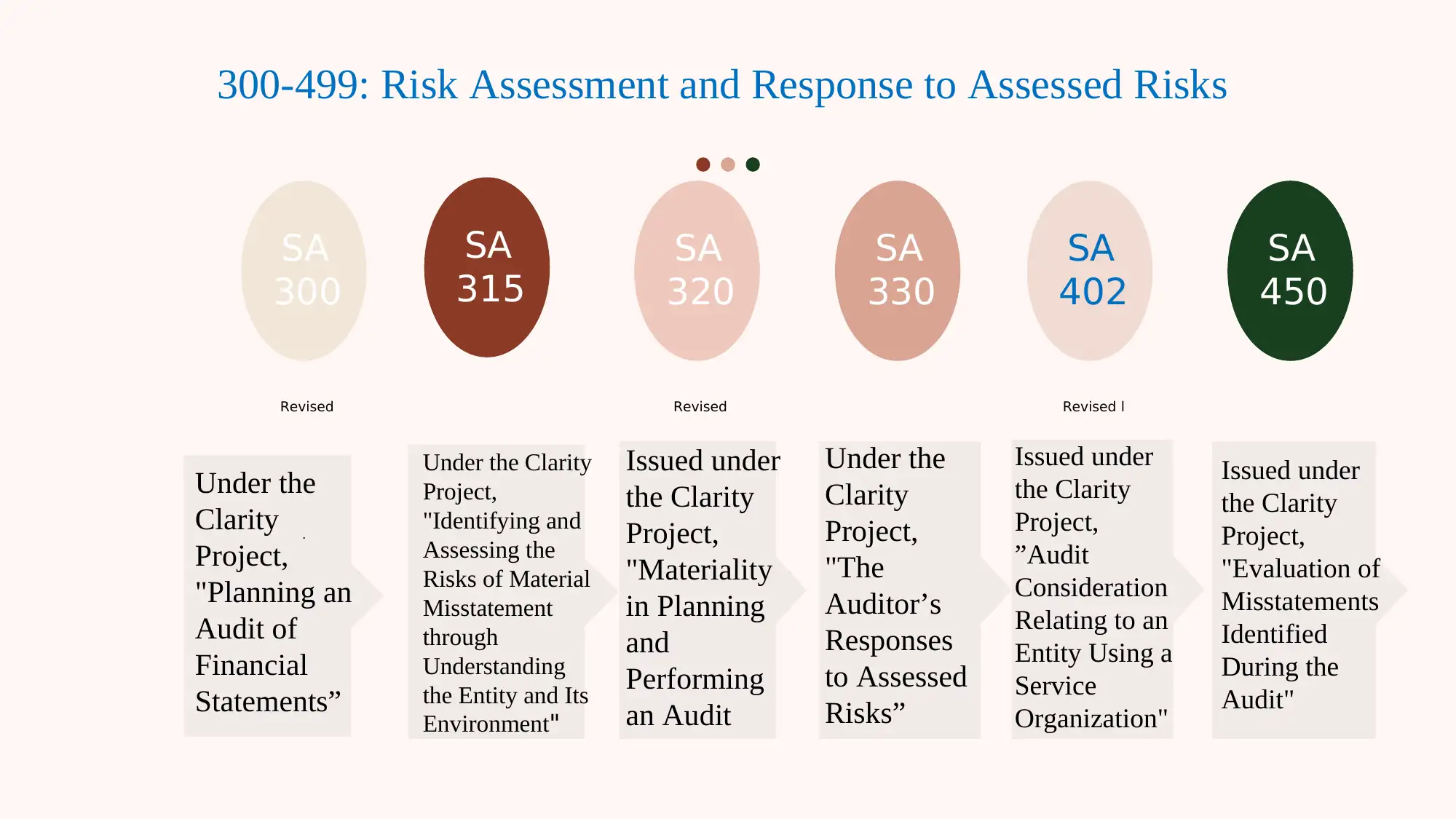
SA
315
SA
320
SA
330
SA
300
Revised Revised
SA
402
SA
450
Revised l
.
300-499: Risk Assessment and Response to Assessed Risks
Under the
Clarity
Project,
"Planning an
Audit of
Financial
Statements”
Under the Clarity
Project,
"Identifying and
Assessing the
Risks of Material
Misstatement
through
Understanding
the Entity and Its
Environment"
Issued under
the Clarity
Project,
"Materiality
in Planning
and
Performing
an Audit
Under the
Clarity
Project,
"The
Auditor’s
Responses
to Assessed
Risks”
Issued under
the Clarity
Project,
”Audit
Consideration
Relating to an
Entity Using a
Service
Organization"
Issued under
the Clarity
Project,
"Evaluation of
Misstatements
Identified
During the
Audit"
315
SA
320
SA
330
SA
300
Revised Revised
SA
402
SA
450
Revised l
.
300-499: Risk Assessment and Response to Assessed Risks
Under the
Clarity
Project,
"Planning an
Audit of
Financial
Statements”
Under the Clarity
Project,
"Identifying and
Assessing the
Risks of Material
Misstatement
through
Understanding
the Entity and Its
Environment"
Issued under
the Clarity
Project,
"Materiality
in Planning
and
Performing
an Audit
Under the
Clarity
Project,
"The
Auditor’s
Responses
to Assessed
Risks”
Issued under
the Clarity
Project,
”Audit
Consideration
Relating to an
Entity Using a
Service
Organization"
Issued under
the Clarity
Project,
"Evaluation of
Misstatements
Identified
During the
Audit"
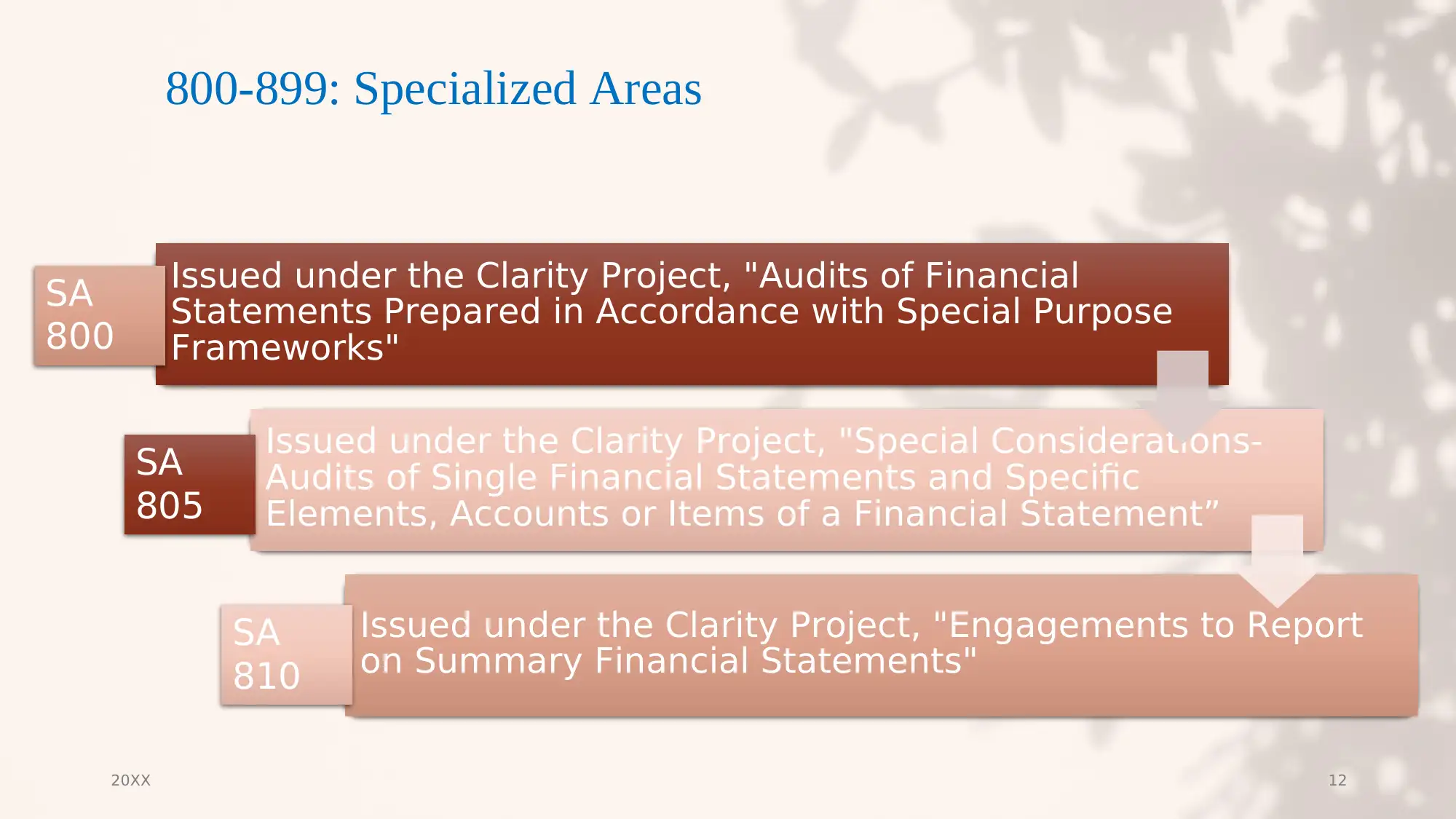
20XX 12
Issued under the Clarity Project, "Audits of Financial
Statements Prepared in Accordance with Special Purpose
Frameworks"
Issued under the Clarity Project, "Special Considerations-
Audits of Single Financial Statements and Specific
Elements, Accounts or Items of a Financial Statement”
Issued under the Clarity Project, "Engagements to Report
on Summary Financial Statements"
SA
800
SA
805
SA
810
800-899: Specialized Areas
Issued under the Clarity Project, "Audits of Financial
Statements Prepared in Accordance with Special Purpose
Frameworks"
Issued under the Clarity Project, "Special Considerations-
Audits of Single Financial Statements and Specific
Elements, Accounts or Items of a Financial Statement”
Issued under the Clarity Project, "Engagements to Report
on Summary Financial Statements"
SA
800
SA
805
SA
810
800-899: Specialized Areas
⊘ This is a preview!⊘
Do you want full access?
Subscribe today to unlock all pages.

Trusted by 1+ million students worldwide
1 out of 14
Related Documents
Your All-in-One AI-Powered Toolkit for Academic Success.
+13062052269
info@desklib.com
Available 24*7 on WhatsApp / Email
![[object Object]](/_next/static/media/star-bottom.7253800d.svg)
Unlock your academic potential
Copyright © 2020–2025 A2Z Services. All Rights Reserved. Developed and managed by ZUCOL.




